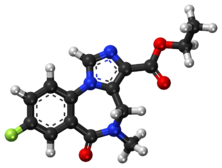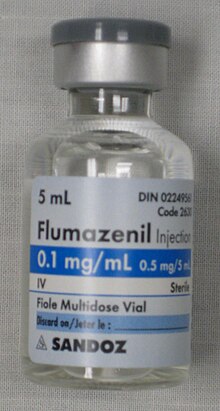 | |
 | |
| Clinical data | |
|---|---|
| Trade names | Anexate, Lanexat, Mazicon, others |
| Other names | ethyl 8-fluoro- 5,6-dihydro- 5-methyl- 6-oxo- 4H- imidazo [1,5-a] [1,4] benzodiazepine- 3-carboxylate |
| AHFS/Drugs.com | Monograph |
| Pregnancy category |
|
| Routes of administration | Intranasal, intravenous |
| ATC code | |
| Legal status | |
| Legal status | |
| Pharmacokinetic data | |
| Metabolism | Hepatic |
| Elimination half-life | 7–15 min (initial) 20–30 min (brain) 40–80 min (terminal) |
| Excretion | Urine 90–95% Feces 5–10% |
| Identifiers | |
| |
| CAS Number | |
| PubChem CID | |
| IUPHAR/BPS | |
| DrugBank | |
| ChemSpider | |
| UNII | |
| KEGG | |
| ChEBI | |
| ChEMBL | |
| CompTox Dashboard (EPA) | |
| ECHA InfoCard | 100.128.069 |
| Chemical and physical data | |
| Formula | C15H14FN3O3 |
| Molar mass | 303.293 g·mol−1 |
| 3D model (JSmol) | |
| |
| |
| (verify) | |

Flumazenil (also known as flumazepil, code name Ro 15-1788[3]) is a selective GABAA receptor antagonist[4] administered via injection, otic insertion, or intranasally. Therapeutically, it acts as both an antagonist and antidote to benzodiazepines (particularly in cases of overdose), through competitive inhibition.
It was first characterized in 1981,[5] and was first marketed in 1987 by Hoffmann-La Roche under the trade name Anexate. However, it did not receive FDA approval until December 20, 1991. The developer lost its exclusive patent rights in 2008; so at present, generic formulations of this drug are available. Intravenous flumazenil is primarily used to treat benzodiazepine overdoses and to help reverse anesthesia. Administration of flumazenil by sublingual lozenge and topical cream has also been tested.[6][7]
- ^ "FDA-sourced list of all drugs with black box warnings (Use Download Full Results and View Query links.)". nctr-crs.fda.gov. FDA. Retrieved 22 Oct 2023.
- ^ Anvisa (2023-03-31). "RDC Nº 784 - Listas de Substâncias Entorpecentes, Psicotrópicas, Precursoras e Outras sob Controle Especial" [Collegiate Board Resolution No. 784 - Lists of Narcotic, Psychotropic, Precursor, and Other Substances under Special Control] (in Brazilian Portuguese). Diário Oficial da União (published 2023-04-04). Archived from the original on 2023-08-03. Retrieved 2023-08-16.
- ^ Hunkeler W, Möhler H, Pieri L, Polc P, Bonetti EP, Cumin R, et al. (April 1981). "Selective antagonists of benzodiazepines". Nature. 290 (5806): 514–516. Bibcode:1981Natur.290..514H. doi:10.1038/290514a0. PMID 6261143. S2CID 4340263.
- ^ Whitwam JG, Amrein R (1995-01-01). "Pharmacology of flumazenil". Acta Anaesthesiologica Scandinavica. Supplementum. 108: 3–14. doi:10.1111/j.1399-6576.1995.tb04374.x. PMID 8693922. S2CID 24494744.
- ^ Whitwam JG (October 1988). "Flumazenil: a benzodiazepine antagonist". BMJ. 297 (6655): 999–1000. doi:10.1136/bmj.297.6655.999. PMC 1834756. PMID 2903780.
- ^ Rye DB, Bliwise DL, Parker K, Trotti LM, Saini P, Fairley J, et al. (November 2012). "Modulation of vigilance in the primary hypersomnias by endogenous enhancement of GABAA receptors". Science Translational Medicine. 4 (161): 161ra151. doi:10.1126/scitranslmed.3004685. PMID 23175709. S2CID 44236050.
- ^ Clinical trial number NCT01183312 for "Flumazenil for the Treatment of Primary Hypersomnia" at ClinicalTrials.gov